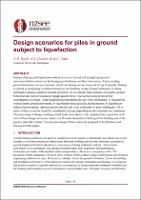| dc.contributor.author | Rolfe, Anthony | |
| dc.contributor.author | Chin, EngLiang | |
| dc.contributor.author | Palmer, Stuart | |
| dc.date.accessioned | 2020-06-18T13:43:07Z | |
| dc.date.available | 2020-06-18T13:43:07Z | |
| dc.date.issued | 2020-04-22 | |
| dc.identifier.uri | https://repo.nzsee.org.nz/xmlui/handle/nzsee/1703 | |
| dc.description.abstract | Seismic shaking and liquefaction with its associated loss of soil strength and ground movements/deformations can be damaging to buildings and their foundations. Understanding ground behaviours and soil-structure interaction during various stages of strong earthquake shaking is critical in developing a resilient foundation and building design. Ground behaviour in strong earthquake shaking cannot be reliably predicted, but we can develop scenarios of possible ground behaviour and test our foundation design against these. Four scenarios are proposed for consideration in design; 1) pre-liquefaction representing the start of an earthquake; 2) liquefaction without lateral ground movement; 3) liquefaction-induced cyclic displacements; 4) liquefaction-induced lateral spread, representing towards the end of an earthquake or post- earthquake. All or some of these scenarios would be considered in design depending on the particular site conditions. The percentage of design building inertial loads (base shear) to be considered in conjunction with each of these design scenarios depends on the natural periods of shaking of the building and of the ground, plus other factors. Various percentages of base shear are proposed in the literature and discussed in this paper. | |
| dc.language.iso | en | |
| dc.publisher | New Zealand Society for Earthquake Engineering | |
| dc.relation.ispartofseries | 2020;46 | |
| dc.subject | Soil-structure interaction | |
| dc.title | Design scenarios for piles in ground subject to liquefaction | |
| dc.type | Article | |

